Introduced in or about 1884 by Marlin for the Ballard single-shot and Model 1881 Marlin repeating rifles, the .38-55 replaced its predecessor, the .38-50 Ballard cartridge. Other than being approximately ?-inch longer in its case and thus holding another five grains of black powder, the .38-55 practically duplicated the older round, and was soon even more widely known than had the .38-50 as a target cartridge for short and mid-ranges.
The .38-50s and .38-55s were supreme during the 1880s. And although faced with tough competition from the .32-35 and .32-40 after 1890, the .38-55 managed to hold its own at ranges of 200 yards and 40 rods (or 220 yards). Possessed of mild recoil, many makers chambered fine match rifles for it. These included Bullard, Farrow, Remington Rolling-Block, Remington-Hepburn, Winchester High Wall, Stevens Model 44 and in 1903, the Stevens Model 44½. Sporting style single-shots and repeating rifles were also sold, first with the Marlin Model 1891 and then the Colt Lighting pump, the Model 1893 Marlin (my first .38-55), the Model 1894 Winchester, Remington-Lee bolt actions, and finally the 1899 Savage Model 99.
The cartridge soon developed a good reputation as a killer of deer and black bear to 150 yards especially following the introduction of the "High Velocity" and "High Power" smokeless powder loadings. Due to its flat-nosed, relatively heavy bullets of good diameter and sectional density, it proved capable of downing game of this size neatly without a lot of meat destruction. There was no better cartridge for both hunting and match shooting at the time. This was because the smaller cartridges lacked power for reliable use on big game and the larger cartridges were seldom as accurate.
Those earliest lead bullet black powder loads had a muzzle velocity of only 1,321 fps but still retained a speed slightly in excess of 1,000 fps at 200 yards. Kinetic energy was a low 988 foot-pounds. The same ballistics applied to the first smokeless loads but with its adoption as a hunting round, demand grew for a faster, more powerful loading suited to the new and stronger rifles that had been developed in the 1890s.
The ammunition makers answered this call with a High Velocity load reaching 1,593 fps for 1437 FPE, and later still a High Power round which drove the 255-grain bullet to 1,700 fps and 1,635 FPE. Where the original rounds had an arched trajectory some 13½ inches halfway to the 200-yard mark, trajectory of the High Velocity loads was 9½ inches, and only a bit over 8 inches with the High Power load. Pressures likewise increased, from a modest 18-20,000 PSI in the black powder and low-pressure smokeless rounds, to some 28-30,000 PSI in the High Velocity ammunition, and 32-34,000 PSI in High Power loads.
Now, the cartridge may be undergoing a revival as a cartridge for the long-range Cowboy shooters. This new demand has encouraged supply of components, particularly bullets.
There is but one source for factory ammunition and that is the Winchester brand of a 255/1300 load. Occasionally one can find the excellent Dominion -CIL brand load of 255/1600. The sources of brass are similarly limited to the Winchester brand. But now Starline has brass in both lengths, new and old and it is good brass. New and old? Well, that's one other thing that should be mentioned here and that is that the brass has been shortened from 2.120" to 2.075" or about 0.145". This is sufficient to make older seating/crimping dies inappropriate, as they are unable to even remove the belling of these shorter cases. If you have an older set of dies it is possible to order only a seating die to work with the newer brass which is the tact I took. Of course the older die can be shortened and will then work, properly adjusted, with both types of brass.
There are many sources for bullets. For jacketed bullets the finest is probably the Barnes Original in either .375 or .377 diameter from most volume mail order houses or special order through your local gun shop. Lead bullets are available from many sources as follows: Lead Head Bullets, Western Bullet Company, Cast Performance Bullet Company, MidwayUSA, Beartooth Bullets.
Sometimes it is possible to acquire second hand partial or complete boxes of Remington or other brands of .375/.377 bullets. As long as the price is less than the Barnes (currently $30 or so plus shipping), these will suit well. Using this method I was able to run across 19 FMJ 255 bullets of Remington manufacture. These were accompanied by 20 of the standard soft points.
I've also found a new source, that being private maker in Florida, Dave Deering (aka Stone Fence). Dave makes some wonderful .375" bullets that actually weigh 255 gr. AND have a more blunt profile than the Barnes bullet. This means that they are shorter for their weight compared to the Barnes and that might be important to users of lever action rifles. These bullets are wonderfully accurate in my rifle and by all tests are strong enough to work at 2000 fps.
The Rifle -My .38-55 Bullberry Barrel Contender Carbine
In order to shoot any cartridge you need a rifle to fire it. While many rifles have been chambered to fire the .38-55 Ballard or Winchester round, few are currently manufactured for it.

Full View of the Contender Carbine as .38-55
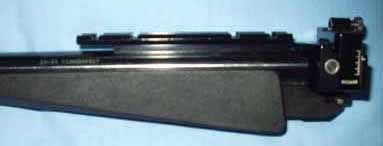
Side View of Scope Mount and Williams Foolproof
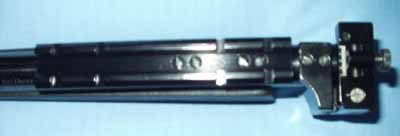
Top View of Scope Mount and Williams Foolproof
I've long admired the mechanical simplicity of the Contender pistol as manufactured by the Thompson Center Firearms Company of New Hampshire. However, I did not want to use it as a pistol but wanted to convert it to a carbine or rifle configuration. I spent a large part of my nearly 4 year tour in the Republic of Korea (1977-1981) reading and dreaming of converting the break open action Contender into a nifty light rifle.
My Contender Carbine set up as a .38-55 Winchester rifle.
Unfortunately, this was not to be for many years as I struggled to care for a growing family and with the restrictions on firearm ownership that are part and parcel of serving in the armed forces overseas. Finally, after enduring a divorce and settling down with a more understanding wife, I was able to begin acquisition of the finer things in life. After a brief fling with an early AR-15 Carbine, rising prices for that particular weapon and dissatisfaction with rapid fire moved me to sell the AR-15 and purchase my first Contender with 2 barrels. A .223 Remington and a .35 Remington, it snowballed from there finally (currently) ending with 18 barrels of various chamberings and lengths. Still, I did not have a .38-55.
However, I've not been completely remiss in exploring this cartridge. Once, immediately after high school and before entering the Army, I bought a used (very) Marlin M1893 with a formerly 26 inch octagon barrel now appearing as a 19¾ inch with a full-length magazine tube. Although I had to replace the magazine spring and stock, this rifle was a fine shooter and hardly recoiled even with the CIL-Dominion High Velocity loads that I had to shoot. I purchased reloading tools and Hornady 220 grain bullets (which were developed for the .375 Winchester, progeny of the .38-55) After a couple of years a friend came to me and asked if I could reload the .38-55 for a Winchester rifle he was about to purchase.
Loading
Well, I've read a lot and done a lot of reloading of this cartridge over the years and yet, I hear something new all the time. I'll try to address all the problems I've experienced but if I forget something, please ask.
Case preparation is critical and follows a strict procedure. I'll start with a new case and run through the drill. First, all factory new cases must be sized in the full-length sizing die. This uniforms the cases and particularly the case mouths before the next step, trimming.
Trimming is absolutely critical with any cartridge that will be crimped on the bullet as will the .38-55. It ensures that you have a consistent length that will make adjusting the crimping die so very much easier. I trim all my cases to either 2.075" or 2.1295". You see with the .38-55, there's the old case length of 2.1295" or the new standard of 2.075". Older die sets sometimes won't crimp the newer cases. More about that later. Chamfering the case follows all trimming. I deburr the case mouth outside and inside.
One must have completed chamfering/deburring before this next step, belling. There are a couple of options here. One can use the die provided or purchase the Lyman M die. I use the RCBS set as sold BUT many report a more consistent seating of the bullet AND a more concentric seating of the bullet when using the Lyman M die. It is worth looking into. Please note that the M die is a separate action and die and can't be combined with the normal belling step. This step is necessary to ease the bullet into the case and particularly necessary in the .38-55. Why? Because, the case mouths are thin and will tear or buckle if the bullet can't be easily seated. It is ALSO important to ensure that the expansion plug, belling stem, or whatever you want to call it is of the correct diameter and works with your choice of bullet diameter. The .38-55 uses bullets of .375" to .380" and that's quite a range. While the case needs to grip the bullet firmly, there is no need to deform the bullet (and maybe harm accuracy) by having too firm a grip.
The next step is to prime. I use the CCI 200 large rifle primer exclusively. I have found no reason to use any other primer.
Now we must charge the case and seat the bullet. Here's where it all comes together. Some will have problems with the bullet being seated non-concentrically and causing a bulge on one side or the other. If it chambers, let it go. Make certain the case is all the way into the shell holder before seating the bullet. Also, as mentioned, having the case mouth expanded to the proper diameter will mitigate this problem. However, I believe a lot is in technique. I use bullets of from .375" to .379" in diameter with no such problems.
Crimping is absolutely necessary for cartridges used with repeaters. I feel that cartridges that will feed absolutely every time best serve such guns. Power, etc. mean nothing if you can't feed shells from the magazine. Rounds loaded for the Contender don't need to be crimped but the die should be adjusted to take the belling from the case. Here's where the two different case lengths and die adjustment are critical. The seating die set up for the old case length (and I have a set) will not crimp the new shorter length cases. Since I have both length of case, I simply got a new seating die and the two seating dies are set up for the two different case lengths.
There are a number of powders that can be used with the .38-55. I've listed loads that I've had success with. If it didn't work for me, I didn't list a load with that powder. That doesn't mean I didn't try that powder, only that it did not work for me.
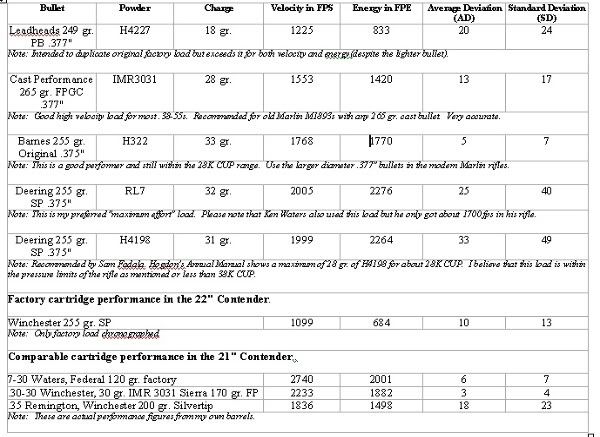
One thing I found in my reloading research is that several people have used the load of 32 gr. of RL-7 (Reloader 7) with 255 gr. jacketed bullets but have gotten widely varying velocities. Ken Waters cites the load in "Pet Loads" but only gets a little more than 1700 fps. Layne Simpson recently mentioned the load in an article on leverguns but he got over 1800 fps. Yet another writer, Christian H. Helbig, in an article "Loading the .38-55" republished in "Big Bore Rifles and Cartridges" uses up to 33 gr. of RL-7 but gets only 1825 fps. I tested it several times and continue to get the average of 2005 fps shown in the chart. All barrel lengths were approximately the same length as mine or even a bit longer. Don't know quite why this is always so as this is not a notably "fast" barrel. However RL-7 has changed a bit and the earlier version(s) might have given such results.
How do I know this? Because with all other loads I get very much what is forecast and what others get with the same load in their barrels.
By the way, Mr. Helbig's article is interesting in that he feels the same about loading the .38-55 to .30-30 pressure levels. He says,
Since this case has the same base diameter as the .30-30, it can be loaded to the same pressures (in the aforementioned rifles) as the .30-30. Back-thrust or stress on the action will be the same and these rifles are perfectly OK for modern .30-30 loads of 38,000 PSI, (factory load pressures).
Mr. Helbig also loads (or loaded) the .38-55 with No. 4198 (which became IMR4198 and is similar to H4198) using 31 gr. under the 265 gr. cast lead gas check bullet from the Lyman 375296 mold. However, he only got 1870 fps. He used a Marlin 336 with a new surplus 1893 barrel.
Sam Fadala apparently feels the same way about loading the .38-55 and it is "his" load of 31 gr. of H4198 that began my experiments beyond the 28,000 PSI range intended to keep the old Ballard rifles safe and intact (as well as their shooters!).
Related articles by other authors:
- "Levergun loads: the .38-55 Winchester; another fine levergun cartridge gets the Taffin treatment" Guns Magazine, June 2003 by John Taffin
- "Loading the .38-55" republished in "Big Bore Rifles and Cartridges" February 1991 by Christian H. Helbig
- "Marlin's .38-55 - Long Range Cowboy Levergun" Guns Magazine, Feb, 2000 by John Taffin
- "Serious ammunition: heavy duty factory loads for the big-bore levergun"
Guns Magazine, March, 2004 by John Taffin
As some of you who have an interest in this old cartridge know, I've been pursuing a wide range of loads. Using Stone Fence's 255 gr. jacketed .375" bullets (excellent for consistency!, thanks Stone Fence) and the subject powders, I did a bit of a run up to the limits I was looking for. Case expansion was measured using the Ken Waters method and in my rifle, no load is apparently excessive. Cases used were once fired Winchester (the newer "short" cases) and primers were all CCI 34. My gun is a Thompson Center Contender with 22" Bullberry barrel bored to .375" and chambered to the .38-55 cartridge.
The H4198 charge is one that Sam Fadala wrote up in Shooting Illustrated for use in HIS Marlin M336CB. He'd made a couple of modifications to the gun's trigger, springs and the cross-bolt safety. The RL-7 charge is one I've seen a couple of places. Both charges exceed manual recommendations and if used are at your own risk. I accept no responsibility for your reloading practices.
Yep, the recoil level is up there in this light gun, approximately 23 fpe free recoil energy. Cases fell right out when the gun was opened and the barrel turned down (and I know that doesn't necessarily mean anything). Accuracy seems good, but this is one cartridge that has to be rezeroed for every load and there is a wide change in sight elevation between the slow 1300 fps loads and these loads.
1900 fps was my goal and I exceeded that. I feel that the .38-55 cartridge is vastly underloaded because all the listed loads are for the Ballard rifles' limits of about 28,000 CUP (or less). This much like the situation with the .45-70 and the relationship of that cartridge to the Trapdoor and the modern Marlin. I think it is also true that the .38-55 could be loaded to .30-30 pressure levels safely. That's about another 10-12,000 CUP. Even the modern short case is longer than the .375 Winchester.



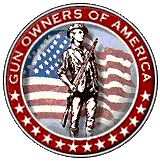






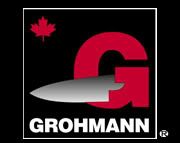
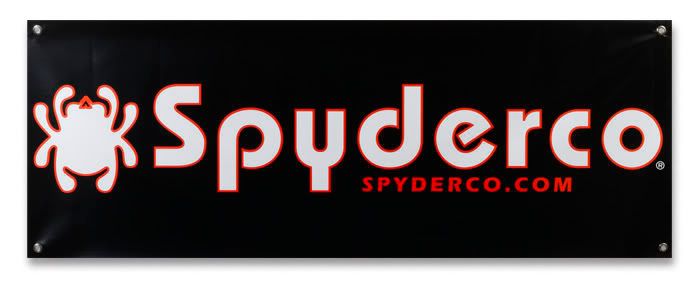

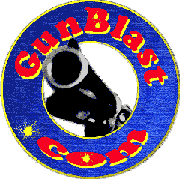








No comments:
Post a Comment